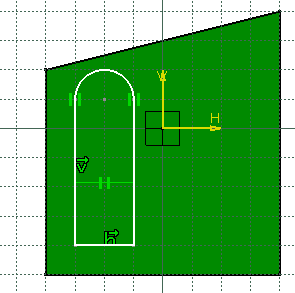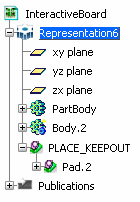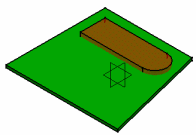Optional: Select Insert
> Body to create the pad corresponding to the constraint area
in a new body.
Body.2 is created and belongs to the interactive board.
Draw the outline of the constraint area.
To do so:
- Click Sketch
 .
.
- Select the board to define the working plane.
- Click Profile
 and draw a contour for the constraint area.
and draw a contour for the constraint area.

- Click Exit workbench
 to return to Circuit Board Design.
to return to Circuit Board Design.
Note: You can also use a 3D curve for the outline. However,
if you want to export the constraint area, you must define an
axis system.
For more information, see
Export.
Create the shape for the constraint area.
To do so
:
- Click Pad
 .
.
- In the Pad Definition dialog box, enter 5mm
in the Length box.
- Click OK to validate.
Click Constraint Area
 .
.
The Constraint Areas
dialog box opens.
Constraint area types are:
-
ROUTE_OUTLINE: An area on the board or panel where routing
electrical connections is allowed.
-
PLACE_OUTLINE: An area on the board or panel within
which component placement is allowed.
-
OTHER_OUTLINE: Additional area type defined by an outline,
cutouts and a thickness.
-
VIA_KEEPOUT: An area on the board or panel within which
placement of vias is not allowed.
-
PLACE_KEEPOUT: An area on the board or panel where component
height is limited.
-
PLACE_REGION: An area on the board or panel within which
placement is limited to certain types of component.
-
ROUTE_KEEPOUT: An area on the board or panel where routing
electrical connections is not allowed.
Select PLACE_KEEPOUT and click OK.
Constraint areas are transparent. The color depends on the type selected.
The color can be changed in
Graphic.
Constraint areas are grouped by type in the specification tree.


Note: The pad is more than a simple pad. It has technological properties.